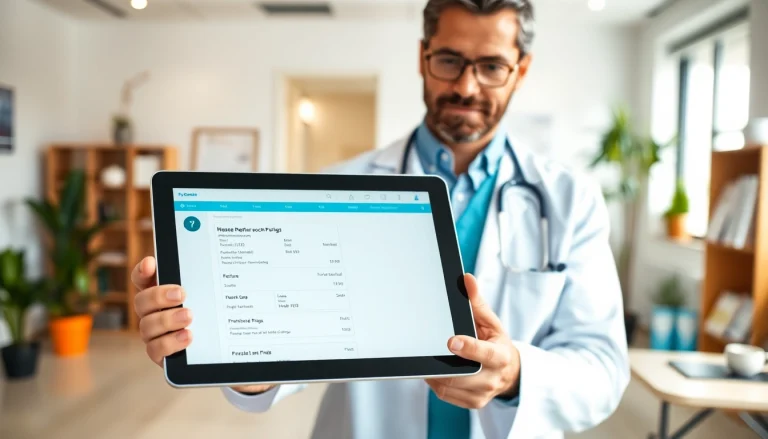Understanding Eprescription Apps
What Are Eprescription Apps?
Eprescription apps are digital platforms designed to facilitate the electronic transmission of prescriptions from healthcare providers to pharmacies. Unlike traditional paper-based systems, these apps streamline the prescription process, minimizing potential errors and improving overall efficiency. They allow healthcare professionals to create, manage, and send prescriptions electronically, ensuring that patients receive their medications promptly and accurately. The integration of these apps into healthcare systems addresses common challenges such as illegible handwriting, lost prescriptions, and delays in medication delivery.
Benefits of Integrating Eprescription Apps
The decision to implement integrating eprescription apps brings numerous advantages to healthcare providers, pharmacies, and patients alike. Some of the primary benefits include:
- Enhanced Accuracy: Eprescriptions significantly reduce medication errors caused by illegible handwriting or miscommunication. This accuracy helps in preventing adverse drug events and improves patient safety.
- Improved Efficiency: The electronic transmission of prescriptions speeds up the process, allowing pharmacists to prepare medications before patients arrive, thus saving time for both parties.
- Real-Time Access to Patient Data: Eprescription apps provide healthcare providers with immediate access to a patient’s medication history, thereby supporting informed decision-making and reducing the risk of drug interactions.
- Cost-Effectiveness: By reducing paperwork and streamlining workflows, healthcare facilities can lower operational costs associated with prescription management.
- Better Patient Engagement: Patients receive notifications regarding their prescriptions and can quickly communicate with their healthcare providers if any issues arise.
Common Misconceptions About Eprescription Apps
Despite the clear advantages, several misconceptions about eprescription apps can hinder their adoption. Addressing these myths is crucial for promoting the technology:
- Myth 1: Eprescription is just a trend. In reality, the shift towards electronic prescriptions is rooted in regulatory requirements aimed at improving patient safety and healthcare efficiency.
- Myth 2: Eprescription apps are complicated to use. Many modern systems are designed with user-friendliness in mind, featuring intuitive interfaces that simplify the prescribing process.
- Myth 3: They are not secure. Eprescription apps adhere to stringent data protection regulations, ensuring that sensitive patient information is handled securely.
Setting Up for Integration
Assessing Your Current Systems
Before integrating an eprescription app into your healthcare practice, it is essential to evaluate your existing systems. This assessment should include:
- Current Workflow Review: Examine how prescriptions are currently handled, identifying any inefficiencies or areas for improvement.
- Technology Infrastructure: Ensure that your practice has the necessary hardware and internet connectivity to support the new software.
- Regulatory Compliance: Confirm that your current systems comply with relevant regulations and standards, as this will impact the choice of eprescription solutions.
Choosing the Right Eprescription App
Selecting the appropriate eprescription app involves careful consideration of various factors:
- Features and Functionality: Assess the specific features offered, such as real-time patient data access, medication reconciliation, and integration with electronic health records (EHRs).
- User Support: Investigate the level of customer support provided by the vendor, including training, ongoing technical assistance, and updates.
- Cost: Consider both one-time setup costs and recurring fees, weighing these against expected efficiencies and savings.
- Interoperability: Ensure that the app can integrate seamlessly with existing health IT systems to prevent data silos and enhance usability.
Preparing Your Staff for the Transition
The successful implementation of an eprescription app hinges on staff readiness. Strategies to prepare your team include:
- Training Sessions: Organize comprehensive training for all staff members to familiarize them with the new system, emphasizing hands-on practice and real-life scenarios.
- Feedback Mechanisms: Encourage staff to provide feedback during the training process, allowing for iterative improvements to training materials and methods.
- Role Assignments: Designate specific team members as champions of the new technology to guide their colleagues and foster a comfortable transition.
Implementing Eprescription Apps
Step-by-Step Implementation Guide
The implementation of an eprescription app follows a systematic process:
- Finalize Selection: Conclude your vendor selection process based on features, cost, and support.
- System Configuration: Work with the vendor to customize the app according to your practice’s specific needs and preferences.
- Data Migration: Safely transfer existing patient data into the new system while maintaining data integrity and security.
- Conduct Pilot Testing: Run a small-scale pilot within your practice to identify any issues or adjustments needed before full deployment.
- Full Deployment: Roll out the system to the entire practice with continued support and monitoring to address any immediate concerns.
Training and Support for Users
Ongoing training and support are vital post-implementation:
- Continuous Learning: Offer refresher courses and update sessions as system updates are released or as new features are added.
- Support Channels: Establish clear channels for staff to access help when needed, whether through dedicated technical support staff or vendor resources.
Monitoring and Adjusting the System
Post-implementation monitoring helps ensure that the eprescription app is functioning correctly:
- Audit Processes: Regularly review prescription processes and systems to identify ongoing issues or inefficiencies.
- Adaptations and Adjustments: Stay open to tweaking workflows based on feedback from users and ongoing performance metrics.
Ensuring Compliance and Security
Adhering to Regulatory Standards
Eprescription systems must comply with various health regulations to protect patient information and ensure safe practices. Essential compliance standards include:
- HIPAA Compliance: Ensure that any eprescription app adheres to the Health Insurance Portability and Accountability Act, safeguarding patient data privacy.
- State Laws and Regulations: Be aware of specific state laws regarding the electronic transmission of prescriptions and be sure your solution is compliant.
Best Practices for Data Security
To maintain the integrity and security of patient data:
- Data Encryption: Utilize strong encryption protocols for both data at rest and in transit to protect sensitive information.
- Access Controls: Implement strict access controls to ensure that only authorized personnel can interface with the eprescription app.
- Regular System Audits: Plan for consistent audits of the system to identify vulnerabilities and ensure adherence to security protocols.
Managing Patient Consent and Information
Patient consent is a critical component of utilizing eprescription apps:
- Informed Consent: Clearly communicate to patients how their data will be used and stored. Obtain explicit consent before processing their prescriptions electronically.
- Patient Access: Where feasible, allow patients to access their health information and manage their consent preferences through a patient portal.
Measuring Success After Integration
Key Performance Indicators to Track
Tracking performance after integrating an eprescription app provides insights into its effectiveness:
- Prescription Accuracy Rate: Monitor the percentage of prescriptions filled accurately to identify any persistent issues.
- Time Savings: Measure the average time spent processing prescriptions both before and after integration to evaluate efficiency gains.
- Patient Satisfaction: Conduct regular surveys to assess patient experiences related to the prescription process.
Gathering Feedback from Staff and Patients
Feedback is a valuable tool for continuous improvement:
- Regular Check-Ins: Hold frequent meetings with staff to discuss their experiences and solicit suggestions for improvement.
- Patient Surveys: Utilize post-visit surveys to gather insights from patients regarding their satisfaction with the new prescription process.
Continuously Improving Your Eprescription Process
Investing in enhancements to the eprescription process can lead to long-term benefits:
- Data-Driven Insights: Leverage the data collected from performance metrics to identify areas for improvement and implement necessary changes.
- Implement Feedback Loops: Create a structured feedback mechanism to regularly incorporate suggestions from both staff and patients into future updates.






